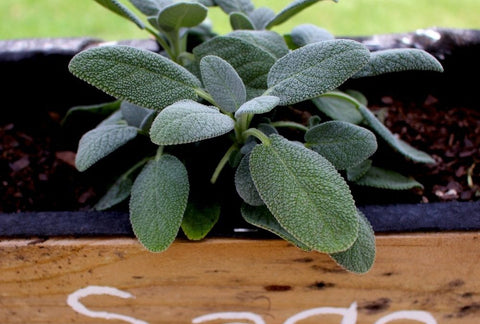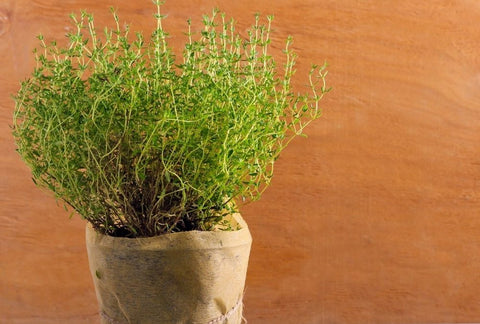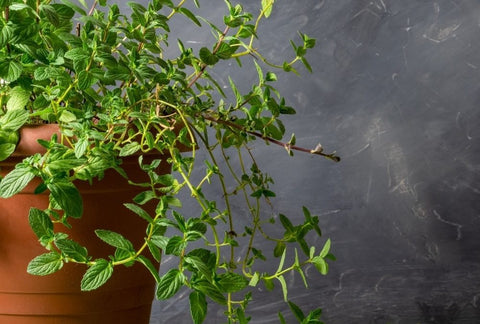For much of its long history, sage has been used as a healing herb – particularly to increase concentration and reason. From this, a particularly wise person became known as a “sage.”

Timing
Sprouts in 2-3 weeks. Harvest from Month 3+ on.

Full sun
Equivalent of 6+ hours of direct sun [DLI of 18+ mol/m²/day].

Care
Beginner friendly. You’ll sprout, thin, and harvest.
How to Grow Sage Indoors: Best Sage Varieties to Grow Inside
The question everyone has is – how to grow sage indoors? Growing sage indoors is easier than you think! There are over 500 different types of sage! Here is a list of the 4 best varieties that can be grown inside your home:
Garden/common
Its leaf is used to make medicine. It is also used for digestive problems, including loss of appetite, gas, stomach pain, diarrhea, bloating, and heartburn.
AmazonBerggarten
This plant is quite ornamental as well as edible and is as much at home in a landscape or flower garden as it is in a designated edibles garden.
Organic SeedsGolden
It has the same aromatic and flavor properties as traditional sage but boasts lovely variegated leaves that are a contrast from the grayish leaves of common garden sage.
Pernell GerverPurple
It can be made into teas to aid in digestion, used as an anti-inflammatory agent for insect bites, and can relieve chest colds and congestion.
AmazonBest Setup for Growing Sage Indoors
To start growing sage indoors, you’ll need:
Planter:
Ceramic Self Watering Planter (preferred) or a pot that is at least 8″ / 1 gal.
Soil:
Free-Draining Mix
Plant Food:
At the start: Balanced Blend. This should be equal parts nitrogen, phosphorus, and potassium (with NPK numbers like 10-10-10).
Ongoing: Herb Blend. This should be high in nitrogen (with NPK numbers like 10-5-5).
Grow Light:
A strong grow light that can give the equivalent of 6+ hours of direct sun [DLI of 18+ mol/m²/day].
Jump to: Our product recommendations
Growing Sage Indoors: Preparing your Planter & Watering Schedule for Sage
Growing sage indoors is quite easy, except in moist soil conditions. The roots are not accustomed to being too wet and will rot in boggy conditions. On the other hand, if the soil dries out completely, the roots will die back and the plant won’t recover. This can catch you off guard because the plant’s not very expressive (its leaves don’t wilt) so it will look fine right up until it dies.
A Ceramic Self Watering Planter filled with a free-draining potting mix self-regulates to keep the soil on the drier side, but with a little consistent moisture (and means no watering guesswork for you). Careful of wick-based self-watering planters with Sage – as they tend to be too wet.
To set one up:

- Fill up the planter with dry soil from the bag, gently tamping down the top.
- Dump the soil into a large mixing bowl and add water until the soil is moist, but not sopping wet (about ½ Cup).
- Mix in 1 tablespoon of the Balanced Blend Plant Food.
If you are using a regular pot instead, it should be a little bit bigger (at least 8″ / 1 gal) and will need drainage holes to prevent it from being overwatered. Let the top of the soil dry out between watering.
Starting your Sage: Seed vs Cutting vs Nursery Plant
New Sage plants can be started from seed, propagated from an established plant, or purchased live at many garden centers. We prefer to sprout from seed or propagate from a stem cutting, as it results in plants that are adapted to your growing conditions and limit the chances that you accidentally bring home pests.
How to Plant Sage Seeds

Sage grows quickly from seed. Plant 1 site in an 8″ / 1 gal container. In larger containers, space sites 4″ apart. For each site, press 4 seeds into the surface. Keep the soil warm (60-70°F, ideally 65°F). Sprouts typically appear in 14 days but can be as quick as 7 days or as long as 21 days depending on your conditions.
Propagating Sage: How to Clone from a Stem Cutting

If you’ve already got a Sage plant you love (or a friend does!), you can easily “clone” it with just sharp scissors and a clean glass of water. First, cut a couple of 6” shoots of new growth (avoid anything woody). Next, remove the lower leaves, so the bottom half is just stem. Place in a glass of 3” of water, making sure the cut leaf spots are underwater. Place the glass on a bright windowsill and change the water every few days. In a couple of weeks, roots should emerge and you can transplant them into your container. While using additional rooting hormones won’t hurt, it’s not necessary with Sage plants.
- Cut a 6” section of new growth.
- Remove leaves halfway and place them in water on a sunny windowsill.
- Wait 14 days for a few ½ inch roots to form and carefully transplant into their final container.
How to Transplant Sage

Live starter plants give you a big jump start on your first harvest. When you’re in a garden center – pick the bushiest plant available (tall and lanky ones will be weak growers) and give it a good inspection for pests. Leaves should be dark green without holes, spots, or curled edges. A best practice is to actually “quarantine” your plant for about a week after bringing it home to make sure it’s free and clear of ride-on pests.
Ensuring it’s pest and disease-free, it’s time to transplant your seedling into its final home.
- Remove some soil from its final planter – leaving enough space for the bottom of the seedling to be just higher than the soil surface.
- Hold on to the base of the stem with one hand, and turn the pot over while gently pulling the seedling. Giving the pot a few squeezes can help dislodge it.
- Place in its final container and fill around it with soil so that it’s tight, but not compacted.
The Right Spot for Growing Sage Indoors
While you should take advantage of the sun (it’s free and perfect for plants), there are limited circumstances where indoor natural light is enough for Sage plants to grow well. A very bright window can cut your grow light needs in half, but if you want to grow lots of Sage, you’ll still need one. For an introduction to grow lights, head over to our post on grow lights for indoor gardeners. We’ve also got a buying guide for screw-in types, but to keep things simple in this guide, we’ll just provide directions for the 24W Screw in Bulb by Sansi, which we think is a good middle-of-the-road option.

How Bright Should Your Grow Light Be?
Sage plants need the equivalent of 6+ hours of direct sunlight [DLI of 18+ mol/m²/day] to grow their best. In order to provide an equivalent amount with a grow light, it needs to be pretty bright! The 24W Sansi bulb should be placed 6 inches away from the top of the plant. This will give your PPFD (the standard measure of brightness) of 500 μmol/m²/s.
How Many Hours Per Day Do Your Sage Plants Need Under a Grow Light?
Sage plants are known as “short-day,” meaning they’ll switch their efforts to making seeds if they sense over 12 hours of darkness. We want to keep them in an earlier stage so we can keep harvesting the leaves, so we recommend setting up a timer to leave it on for at least 14 hours per day.
Sage Plants Grow Faster in Warmer Temps
Sage plants are called “warm-weather crops” and will speed up their metabolism when temperatures are warmer. On the other hand, if things get too hot, they’ll wilt and become prone to disease. Ideal temperatures are around 70°F but anything between 60 and 80°F grows well.
Week 2-3: Check for Sprouts
You could see seedlings in as little as 7 days (though 14 days is more typical). If it’s been 21 days and you still don’t have any sprouts, it’s likely that your setup is too cold.
Week 5: Thin Your Seedlings

Thin your planter to only have 1 seedling per site – leaving the largest plant. If you are using the recommended planter (at least 8″ / 1 gal), this will mean you’ve got 1 plant after thinning. By getting rid of the smaller seedlings, you’re allowing the biggest and strongest one to flourish by reducing its competition for water, food, and space.
If your seedlings are under 1 inch, stretching out, or folding over, it’s likely that they don’t have quite enough light.
Month 2: How to Prune Sage Plants

Once your Sage plant has 3 sets of mature leaves, you’re ready for your first prune. Cut off the top set of mature leaves, leaving the bottom two (it’s best to cut right above the pair of leaves you’re keeping on the plant). Once these branches grow out (and each has a few sets of their own leaves), you can cut the tip – just as you did with the main stem. At this point, your plant will be fairly well shaped, so hone your inner Bonsai master and use your thinning and heading cuts to harvest and shape your herbs as you go.
Month 3+: How to Harvest Sage
As your sage continues to grow, keep harvesting to encourage growth. If you only want a couple of leaves, pick leaves where new ones are emerging at the base.
Year 3+: End of Life
Sage does not easily tolerate summer heat and humidity, but as long as you keep your plants in climate-controlled conditions, they can live a very long time. After about 3 years, you will notice it getting woody and less flavorful, at which point you may choose to start over.
Shop This Blog
The right supplies can take the guesswork out of caring for your plants – and turn care from a daily to weekly routine as you also properly understand how to grow sage indoors. Through our grow tests, we’ve found these products to produce the best indoor Sage (and also have simple maintenance). Plants are adaptable and can grow in many different conditions, so they are by no means necessary if you already have other supplies.
Best Containers for Sage: Ceramic Self Watering Planters
Plants thrive on consistent moisture but can suffer if they’re waterlogged. A semi-porous ceramic self-regulates ideal conditions. Our favorite is the COSWIP planter. Runner up is the XS Self Watering Planter by Wet Pot.
Best Soil for Sage: Free Draining Mix
Sage needs a drier environment – so you are better off using a free-draining cactus potting mix – we like this Organic Mix by Espoma.
Best Nutrients for Sage: Balanced Blend followed by Herb & Lettuce Blend
Sage likes to start with nutrients that are equal parts nitrogen, phosphorus, and potassium (with NPK numbers like 10-10-10). For this Balanced Blend we recommend: Dr Earth All Purpose
Once they are growing, it’s better to use plant food that is high in nitrogen (with NPK numbers like 10-5-5). For this Herb Blend, we recommend: Joyful Dirt All Purpose
Best Light for Sage: DIY or Soltech
There is a very small chance that you have the bright windows needed to grow these without a grow light. If you are looking for a higher-end option – we love the Aspect Light by Soltech. For a more affordable option, a DIY setup using a 24W Screw-in Bulb by Sansi with a Clamp Light and Mechanical Timer works well too. Check out our complete guide on a DIY setup for less than $40 or our buying guide for screw-in bulbs.









There are no comments for this article. Be the first one to leave a message!